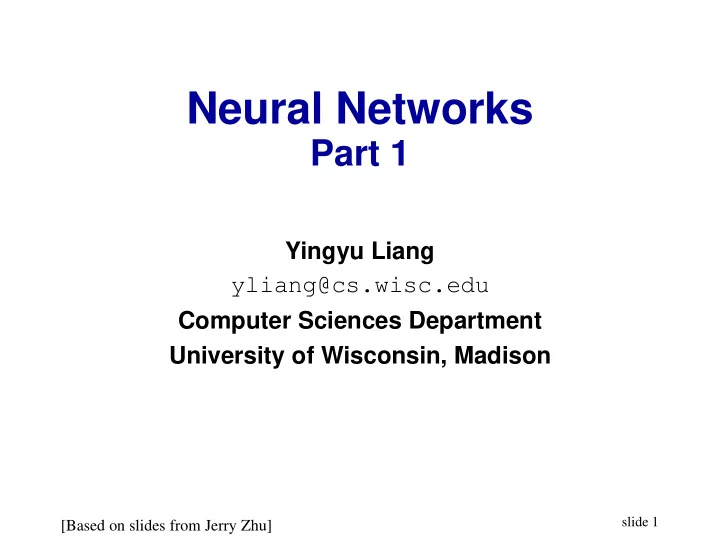

Neural Networks Part 1 Yingyu Liang yliang@cs.wisc.edu Computer Sciences Department University of Wisconsin, Madison slide 1 [Based on slides from Jerry Zhu]
Motivation I: learning features • Example task Experience/Data: images with labels indoor Indoor outdoor slide 2
Motivation I: learning features • Featured designed for the example task Extract features Indoor 0 slide 3
Motivation I: learning features • More complicated tasks: hard to design • Would like to learn features slide 4
Motivation II: neuroscience • Inspirations from human brains • Networks of simple and homogenous units slide 5
Motivation II: neuroscience • Human brain: 100, 000, 000, 000 neurons • Each neuron receives input from 1,000 others • Impulses arrive simultaneously • Added together* ▪ an impulse can either increase or decrease the possibility of nerve pulse firing • If sufficiently strong, a nerve pulse is generated • The pulse forms the input to other neurons. • The interface of two neurons is called a synapse http://www.bris.ac.uk/synaptic/public/brainbasic.html slide 7
Successful applications • Computer vision: object location Slides from Kaimin He, MSRA slide 8
Successful applications • NLP: Question & Answer Figures from the paper “Ask Me Anything: Dynamic Memory Networks for Natural Language Processing ”, by Ankit Kumar, Ozan Irsoy, Peter Ondruska, Mohit Iyyer, James Bradbury, Ishaan Gulrajani, Richard Socher slide 9
Successful applications • Game: AlphaGo slide 10
Outline • A single neuron ▪ Linear perceptron ▪ Non-linear perceptron ▪ Learning of a single perceptron ▪ The power of a single perceptron • Neural network: a network of neurons ▪ Layers, hidden units ▪ Learning of neural network: backpropagation ▪ The power of neural network ▪ Issues • Everything revolves around gradient descent slide 11
Linear perceptron • 1 … slide 13
Learning in linear perceptron • slide 14
Learning in linear perceptron slide 15
Visualization of gradient descent slide 16
The (limited) power of linear perceptron • 1 slide 17
Non-linear perceptron • 1 … slide 18
Non-linear perceptron • 1 … Now we see the reason for bias terms slide 19
Non-linear perceptron for AND • slide 20
Example Question • Will you go to the festival? • Go only if at least two conditions are favorable ? Weather Company Proximity All inputs are binary; 1 is favorable slide 21
Example Question • Will you go to the festival? • Go only if Weather is favorable and at least one of the other two conditions is favorable ? Weather Company Proximity All inputs are binary; 1 is favorable slide 22
Sigmod activation function: Our second non-linear perceptron • slide 23
Sigmod activation function: Our second non-linear perceptron • slide 24
Sigmod activation function: Our second non-linear perceptron • slide 25
Learning in non-linear perceptron slide 26
The (limited) power of non-linear perceptron • Even with a non-linear sigmoid function, the decision boundary a perceptron can produce is still linear • AND, OR, NOT revisited • How about XOR? slide 27
The (limited) power of non-linear perceptron • Even with a non-linear sigmoid function, the decision boundary a perceptron can produce is still linear • AND, OR, NOT revisited • How about XOR? • This contributed to the first AI winter slide 28
Brief history of neural networks slide 29
(Multi-layer) neural network • Given sigmoid perceptrons • Can you produce output like • which had non-linear decision boundarys 0 1 0 1 0 slide 30
Recommend
More recommend